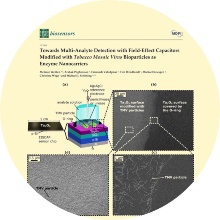Towards Multi‐Analyte Detection with Field‐Effect Capacitors Modified with Tobacco Mosaic Virus Bioparticles as Enzyme Nanocarriers
Welden, M.; Poghossian,A.; Vahidpour, F.; Wendlandt, T.; Keusgen, M; Wege, C; Schöning, M.J. (2022). Biosensors 12, 43. https://doi.org/10.3390/bios12010043
Utilizing an appropriate enzyme immobilization strategy is crucial for designing enzyme-based biosensors. Plant virus‐like particles represent ideal nanoscaffolds for an extremely dense and precise immobilization of enzymes, due to their regular shape, high surface‐to‐volume ratio and high density of surface binding sites. In the present work, tobacco mosaic virus (TMV) particles were applied for the co‐immobilization of penicillinase and urease onto the gate surface of a field‐effect electrolyte‐insulator‐semiconductor capacitor (EISCAP) with a p‐Si‐SiO2‐Ta2O5 layer structure for the sequential detection of penicillin and urea. The TMV‐assisted bi‐enzyme EISCAP biosensor exhibited a high urea and penicillin sensitivity of 54 and 85 mV/dec, respectively, in the concentration range of 0.1–3 mM. For comparison, the characteristics of single‐enzyme EISCAP biosensors modified with TMV particles immobilized with either penicillinase or urease were also investigated. The surface morphology of the TMV‐modified Ta2O5‐gate was analyzed by scanning electron microscopy. Additionally, the bi‐enzyme EISCAP was applied to mimic an XOR (Exclusive OR) enzyme logic gate.


